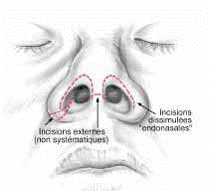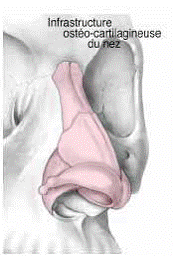|
RHINOPLASTY : COSMETIC NOSE SURGERY
DEFINITION, AIMS AND PRINCIPLES
This procedure aims to modify the shape of the nasal pyramid
(either partially or completely) and can also if necessary
correct nasal breathing problems.
The result should be a nose in harmony with the facial
features, and which corresponds to the personality and
expectations of the patient.
The technique uses incisions hidden inside the nostrils and
remodels the bone and cartilage which give each nose its
distinctive shape. The skin covering these elements will be
redraped and will adapt to the new nose.
This procedure carried out both for men and women, can be
done from the age of 16, when growth is complete.
BEFORE THE OPERATION
The motivation and expectations of the patient will have been
analysed.
Prior to the operation a thorough examination of the nasal
pyramid and its harmony with the other features of the face
will have been carried with an endo-nasal examination.
HOSPITAL STAY AND TYPE OF ANESTHESIA
Type of anesthesia
This operation is usually performed under general anesthesia
or local anesthesia with intravenous
sedation (twilight anesthesia).
Hospital stay
Rhinoplasty is usually carried out in an ambulatory facility,
you arrive early at the hospital and are discharged the same
day after a few hours under observation.
THE PROCEDURE
 Incisions Incisions
As a rule
they are
invisible,
hidden inside the nostrils
there are
therefore no
visible scars.
It can be necessary to use an external incision concealed at
the base of the nose wings if reducing the nostrils, or across
the columna, between the nostrils in order to perform an ‘open’ rhinoplasty (giving access to the internal structure of
the nose. This can be used when repairing serious
deformations or for touch-up surgery.
Reshaping the nose

The osteocartilaginous
structure will then be
reshaped as planned.
The nose may be
made smaller or straightened, a bump removed, the tip may
be redefined, the septum may be straightened or the nasal
concha reduced in size. In some cases a cartilage or bone graft
will be used to fill a hollow zone, to support part of the nose
or redefine the tip.
Dressings and splints
The nostrils are packed with wadding. An external dressing of
tape is applied then a splint of plaster, plastic or metal is
molded and fixed to the nose.
The operation can take between 45 minutes and 2 hours.
AFTER THE OPERATION
There is rarely actual pain, it is rather the fact that the
wadding makes it impossible to breathe through the nose
which is a problem for the first few days.
Swelling can be observed around the eyelids with bruising
which is variable in degree and duration for each patient.
During the first few days rest is advised, with no physical
strain.
The wadding is removed 1 to 3 days after the procedure. The
splint is removed 5 to 8 days after surgery, to be replaced by a
smaller splint for a few more days.
The nose will appear bigger because of swelling and it will
still be difficult to breathe because of swelling of the lining of
the nose and possible scabs in the nostrils.
The visible signs of the operation will disappear gradually
and a return to normal social and professional life is possible
after 10 to 20 days.
Sport and strenuous exercise should be avoided for 3 months.
THE RESULT
Two to three months are necessary before the final result
becomes appreciable, and it will only be after 6 months to one
year that the final aspect will become apparent after a slow
and subtle healing process.
DISAPPOINTING RESULT
These can result from a misunderstanding concerning what
can reasonably be achieved, or be caused by unusual scarring
phenomena or unexpected tissue reactions such as poor
healing and retractile fibrosis.
These imperfections can be remedied by corrective surgery if
necessary, usually under local anesthesia from the 6th month
following surgery. It is necessary to wait until the healing and
scar tissue are stabilised. This touch-up surgery is more
simple than the first procedure both regarding the technique
used and the postoperative care.
POSSIBLE COMPLICATIONS
A rhinoplasty, although essentially an aesthetic procedure, is
nevertheless an operation, and this implies that the risks
inherent to any surgery apply here.
- Bleeding : this can occur in the first few hours after
surgery but is usually moderate. If bleeding persists
more wadding should be added, or a return to the
operating room may be necessary.
- Hematoma : these must be drained if too painful or
too large.
- Infection : in spite of the natural presence of germs
in the nostrils this is very rare.
- Abnormal scarring : this can only concern external
scars (if any) and is rarely a problem to the point of
requiring a second procedure.
|